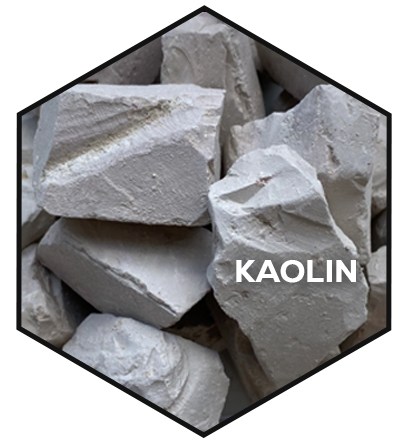
KAOLIN
Kaolin, a naturally occurring clay mineral, is pivotal in various industries due to its remarkable properties. Its fine, white, and soft texture makes it a versatile material, and it is extensively used in the paper, ceramics, and cosmetics industries. In paper production, kaolin serves as a key component to enhance the paper’s printability, brightness, and opacity. It is an essential ingredient in the manufacturing of porcelain and fine china, where it improves the whiteness and smoothness of the final products. Moreover, kaolin’s gentle and non-irritating nature makes it a common ingredient in cosmetics and skin care products like lotions and powders. Geologically, kaolin deposits are found worldwide, with notable sources in the United States, the United Kingdom, China, and Brazil. Its multifaceted applications in various sectors highlight its significance in modern manufacturing and daily life.
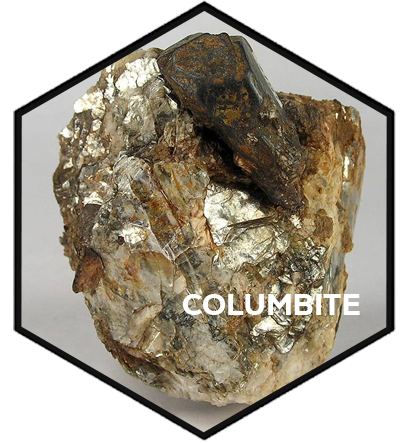
COLUMBITE
Columbite, a mineral with a distinctive dark colour ranging from black to brown, is of notable importance due to its tantalum and niobium content. These two elements are critical in the aerospace and electronics industries. Tantalum, found in columbite, is utilized in manufacturing capacitors for electronic devices due to its ability to store and release electrical energy efficiently. Niobium, another valuable component, is employed in superalloys for applications like jet engines and medical implants. However, the extraction of columbite has been associated with ethical concerns, particularly in conflict regions where proceeds from mineral sales have been linked to funding armed conflicts. As a result, there have been increasing efforts to establish responsible sourcing and ethical mining practices to ensure that columbite and similar minerals are extracted and traded in a manner that respects human rights and environmental standards.
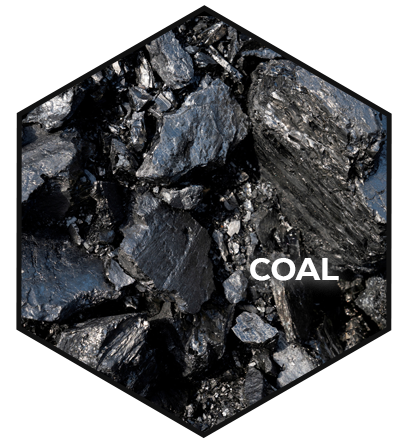
COAL
Coal, a sedimentary rock composed mainly of carbon, has historically been a cornerstone of energy production and industrial development worldwide. It formed from ancient plant remains, accumulating in low-oxygen environments over millions of years. Coal has played a significant role in generating electricity and fueling industrial processes, serving as a primary energy source for over a century. Different types of coal, including lignite, sub-bituminous, bituminous, and anthracite, vary in carbon content and energy output. Despite its widespread use, coal mining and combustion have raised environmental concerns due to air and water pollution, habitat destruction, and greenhouse gas emissions. Efforts to transition to cleaner energy sources, such as natural gas, renewables, and nuclear power, have gained traction to address these environmental issues. Nonetheless, coal remains a vital part of the energy mix in many regions, with abundant reserves in countries like the United States, China, and India. Its historical significance in powering the Industrial Revolution and its continued role in the global energy landscape reflect the complex challenges and opportunities surrounding this fossil fuel.
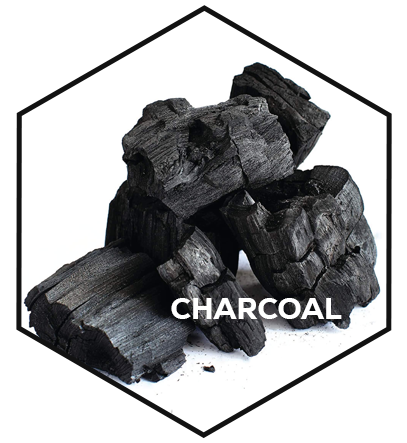
CHARCOAL
Charcoal, a black, porous substance, results from heating wood, peat, coconut shells, or other organic materials without air. It has a rich history of use dating back centuries and finds applications in various domains. Charcoal is renowned for its exceptional absorption properties, making it invaluable for water purification, air filtration, and even medical treatments. Artists have long used charcoal for drawing due to its deep black colour and easy manipulation. In addition, charcoal has been a key fuel source for grilling and cooking, imparting a distinct smoky flavour to food. Charcoal production, however, can have environmental implications, as it often involves deforestation and can contribute to habitat loss. Modern practices aim for sustainability by using waste materials and adopting more efficient production methods. The diverse uses and evolving production methods highlight charcoal’s significance in traditional and contemporary contexts.
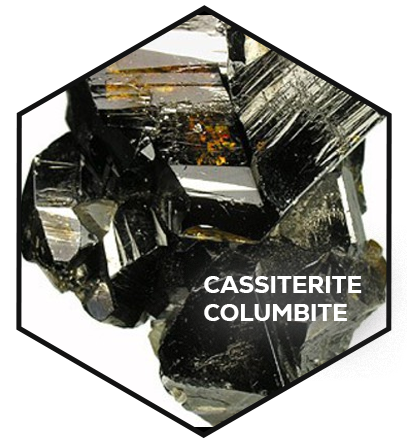
CASSITERITE COLUMBITE
Cassiterite and columbite are both valuable minerals, each known for its unique contributions to various industries. Cassiterite, primarily composed of tin oxide, is a significant ore for tin production. It has a distinctive dark colour and is often found in granite and pegmatite formations. The mining and processing of cassiterite are vital for the production of tin, a versatile metal used in soldering, electronics, and packaging.
Columbite, on the other hand, contains tantalum and niobium, making it crucial for high-tech applications. These elements are used in the manufacturing of capacitors for electronic devices and in superalloys for aerospace and medical applications. Columbite is usually black, brown, or reddish-brown and is often found in association with granite and pegmatite deposits. However, ethical concerns have arisen in regions where columbite mining has been linked to funding armed conflicts, leading to efforts for responsible sourcing and ethical mining practices. Together, cassiterite and columbite exemplify the complex interplay between economic significance and ethical responsibility in the mining industry
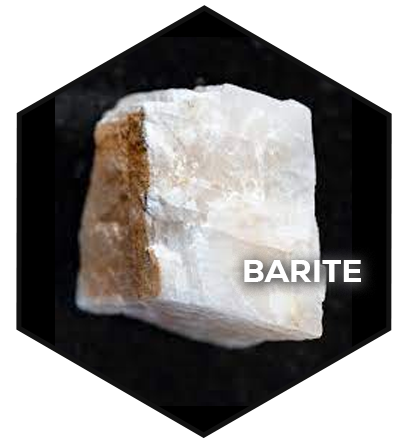
BARITE
Barite, a mineral composed of barium sulfate (BaSO4), boasts several intriguing characteristics. Its appearance varies, spanning white, grey, blue, yellow, or brown, and its crystalline structure typically forms as tabular crystals or massive aggregates. Notably, barite’s radiopaque nature makes it valuable in medical imaging, as it obstructs X-rays, aiding in visualising specific body areas. In industry, it is a weighting agent in drilling fluids for deep drilling within the oil and gas sector, regulating pressure. Barite, etymologically derived from the Greek word “barys” for “heavy” due to its high density, has been historically significant. It continues to find applications in diverse fields, albeit with environmental concerns necessitating sustainable mining practices. The barite is broadly used in applications including middle & high-grade paint, paper-making, pharmaceuticals, rubber, cosmetics, and plastics.
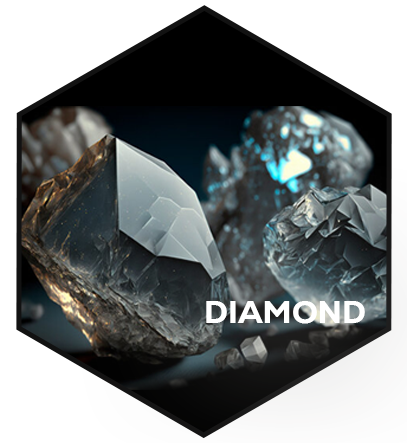
DIAMOND
Diamonds are among the most coveted and precious gemstones known for their brilliance, hardness, and rarity. Composed of carbon atoms arranged in a crystal lattice structure, diamonds are renowned for their exceptional optical properties, including dispersion, which creates the famous play of rainbow-coloured light known as fire. Formed deep within the Earth’s mantle under immense heat and pressure, diamonds are brought to the surface through volcanic eruptions in volcanic pipes called kimberlite and lamproite. These geological processes take millions of years, making diamonds exceedingly rare. While they have been traditionally associated with jewelry, diamonds also have industrial applications, as their hardness makes them valuable for cutting, grinding, and drilling. The diamond trade has been marked by issues related to conflict or “blood diamonds,” leading to international efforts to establish ethical sourcing practices, such as the Kimberley Process Certification Scheme, to ensure that diamonds are mined and traded without financing armed conflicts or human rights abuses.
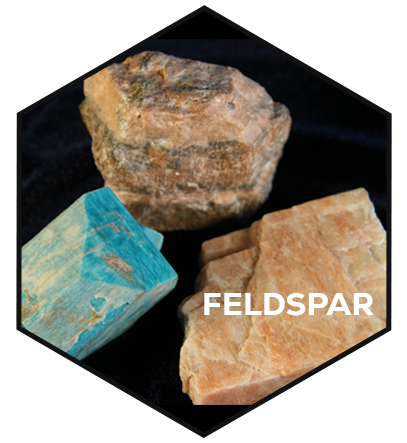
FELDSPAR
Feldspar is a common and versatile group of minerals in the Earth’s crust, composed of aluminium, silicon, and oxygen atoms. It is a key component of many rocks, including granite, and is abundant in the Earth’s crust. Feldspar comes in several varieties, with orthoclase, plagioclase, and microcline being the most common. Its name is derived from the German words “feld,” meaning field, and “spath,” meaning rock, reflecting its widespread occurrence in nature. Feldspar’s uses are diverse; it is a major raw material in the production of ceramics, glass, and glazes due to its ability to lower the melting temperature of these materials. Additionally, it finds applications in the construction industry for making tiles and as a filler in various products. Its presence in geological formations and broad utility in various industrial processes highlight the importance of feldspar in both natural and man-made materials.
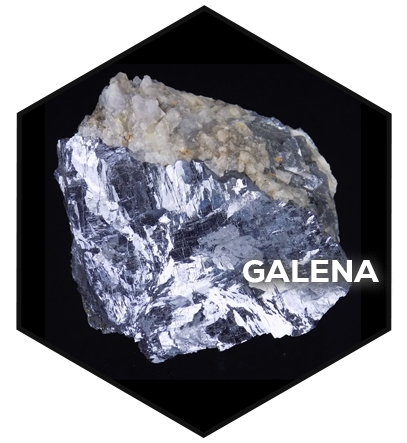
GALENA
Galena is a mineral that holds a distinctive place in the realm of geology and history. It is the primary ore of lead, composed of lead sulfide (PbS), and is one of the most important sources of lead, which has been used by humans for thousands of years. Galena has a characteristic metallic lustre, and its dark grey or silver colour makes it easily distinguishable. Historically, lead extracted from galena has been widely used in a range of applications, including pipes, bullets, and even cosmetics. However, lead is toxic, and the dangers of lead exposure have become well-known, leading to a significant reduction in its use. In modern times, the primary value of galena lies in its role as an important mineral specimen for collectors, as its cubic crystal form and metallic appearance are highly sought after in the field of mineralogy. Additionally, galena’s presence in certain geological formations can be indicative of valuable mineral deposits, and its economic importance has had a profound impact on the mining industry and society’s understanding of the element lead.
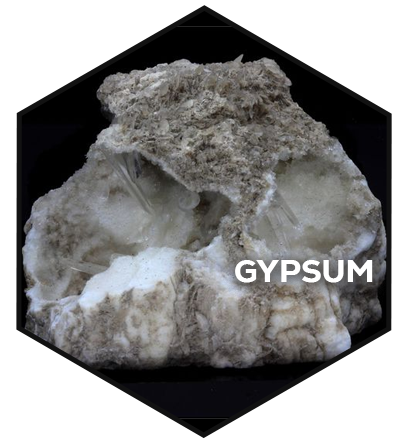
GYPSUM
Gypsum is a mineral with a multitude of uses and a fascinating history. Composed of calcium sulfate dihydrate (CaSO4·2H2O), it is renowned for its characteristic white or colourless appearance and its softness, which allows it to be easily scratched by a fingernail. Gypsum is most famously associated with its use in the construction industry as a key ingredient in drywall, plaster, and cement. Its ability to harden when mixed with water and then return to a soft state as it dries makes it indispensable in these applications. Beyond construction, gypsum has agricultural uses as a soil conditioner to improve crop yields and as a component in certain fertilizers. It also plays a crucial role in industries such as medicine, where it is used in dental plaster and casts, and in art, where it is a traditional material for sculpting and creating intricate stucco and ornamental designs. Its versatile nature and wide-ranging applications underscore gypsum’s significance in various aspects of daily life and industry.

LEAD
Lead is a heavy and versatile metal that has left an indelible mark on human history. Its atomic symbol Pb is derived from the Latin word “plumbum.” Lead has been used for thousands of years due to its malleability, density, and low melting point. In ancient times, it was employed for making water pipes, which is how it acquired the word “plumbing.” Lead also found use in paints, cosmetics, and as a sweetener in food, though its toxic effects on health have become increasingly apparent over time. The adverse impact of lead exposure, especially on children’s cognitive development, has led to stringent regulations to limit its use. Nonetheless, lead still has valuable applications in batteries, radiation shielding, and certain specialized alloys. Its historical significance and complex relationship with human health and industry have made lead a subject of continued study and regulatory control, emphasizing the need for responsible handling and disposal of this metal.
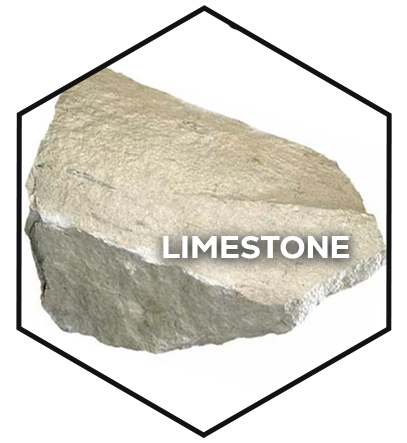
LIMESTONE
Limestone, a sedimentary rock predominantly composed of calcium carbonate, has a rich geological and practical significance. It forms over millions of years from the accumulation of shells, coral, and other calcium-rich materials on the ocean floor. Limestone comes in various colours and textures and is known for its durability, making it a sought-after construction material for buildings, roads, and monuments. Its chemical properties make it a crucial ingredient in the production of cement and concrete, as it provides the binding component. Limestone is also employed in the steel industry as a flux to remove impurities during the smelting process. Beyond its industrial uses, limestone formations and caves, like the famous Carlsbad Caverns, are a testament to the intricate beauty of nature and offer opportunities for geological research and tourism. As a rock with a wide range of applications, limestone has played an integral role in shaping both the natural landscape and the built environment.
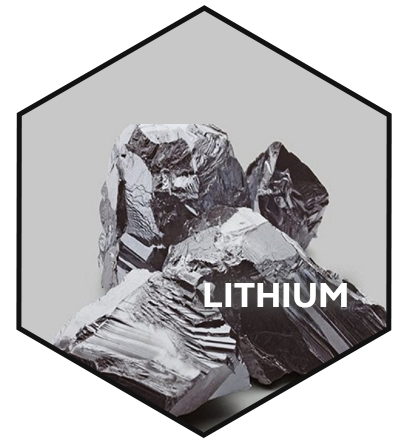
LITHIUM
Lithium is a unique and valuable element known for its essential role in modern technology and energy storage. It is the lightest metal and the least dense solid element on the periodic table, making it highly reactive. Lithium-ion batteries, a revolutionary innovation, have transformed the way we power portable electronics, electric vehicles, and renewable energy systems. These batteries store and release energy efficiently and are a driving force behind the transition to cleaner and more sustainable energy sources. Moreover, lithium’s therapeutic properties have led to its use in psychiatric medication for conditions like bipolar disorder. The growing demand for lithium has led to increased exploration and mining activities, particularly in regions with abundant lithium deposits like South America and Australia. This element’s significance in energy storage and mental health underscores its pivotal role in addressing contemporary challenges related to environmental sustainability and human well-being.
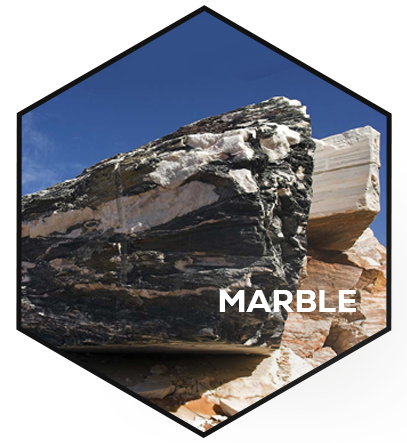
MARBLE
Marble, a metamorphic rock formed from limestone under intense heat and pressure, is celebrated for its exquisite beauty and versatility. Renowned for its lustrous surface and a variety of colours and veining patterns, marble has been cherished as a favoured material for sculptors and architects throughout history. Iconic sculptures such as Michelangelo’s “David” and architectural wonders like the Taj Mahal are testament to its enduring appeal. In construction and interior design, marble is employed for its elegance and timelessness, used for floors, countertops, and decorative elements. Despite its aesthetic allure, marble is susceptible to staining and erosion, which has prompted the development of protective sealants and responsible maintenance practices. The geological processes that transform limestone into marble over millennia give rise to this captivating stone, emphasizing its significance in both art and design.
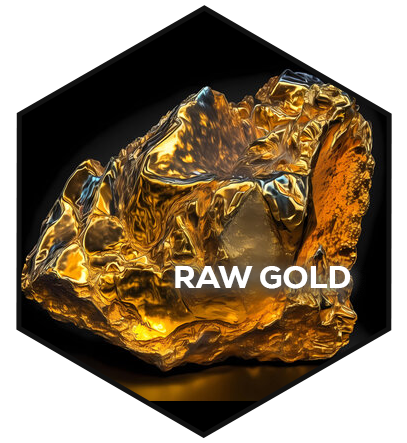
RAW GOLD
Raw gold, often referred to as “gold ore,” is the natural and unrefined state of this precious metal as it is found in the Earth’s crust. Gold ore is typically a mix of gold and various other minerals and impurities. The quest for gold has been a driving force throughout human history, leading to the gold rushes and exploration that shaped regions like California and the Klondike in the 19th century. Extracting gold from raw ore involves various processes, including mining, crushing, and chemical extraction, with cyanide leaching being a common method. Once extracted, gold goes through refining processes to achieve the high levels of purity and quality needed for use in jewelry, coins, and various industrial applications. Raw gold’s allure lies in its natural beauty and rarity, serving as both a valuable commodity and a symbol of wealth and prestige throughout the ages.
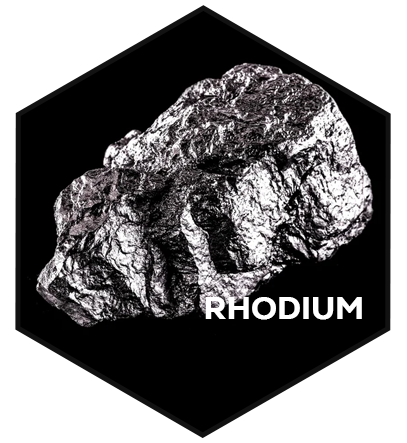
RHODIUM
Rhodium, a rare and silvery-white transition metal, holds a unique place in the world of precious metals. It is part of the platinum group metals and is renowned for its remarkable properties, including exceptional resistance to corrosion and a dazzling luster. Rhodium has a range of practical applications, with the most prominent being in the automotive industry, where it is used to coat the catalytic converters of vehicles, helping to reduce harmful emissions. Its use in fine jewelry as a plating material enhances the durability and reflective qualities of white gold and platinum, creating a lustrous finish. Rhodium is also employed in the electronics and electrical industries as a coating for electrical contacts. Due to its rarity, it is one of the most expensive metals in the world, with its price sometimes surpassing that of gold or platinum. The significance of rhodium stems from its critical role in environmental protection and its unique contributions to various high-value applications.
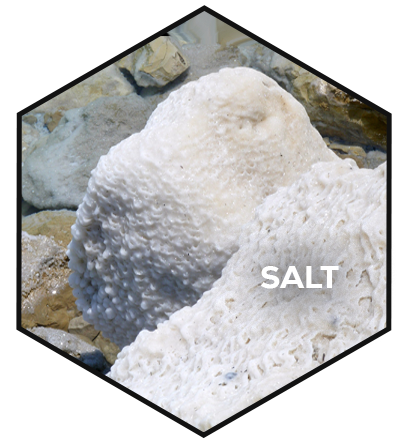
SALT
Salt, primarily sodium chloride (NaCl), is a fundamental mineral that has played an essential role in human history and daily life. Its significance goes far beyond flavouring food; salt has been a precious commodity, sometimes referred to as “white gold,” for millennia. It has been used as a preservative for food, enabling people to store and transport goods over long distances, contributing to the development of ancient trade routes. Salt has also been a source of taxation and conflict in various historical periods. Today, it is indispensable in food preservation, seasoning, and industrial processes, particularly in the chemical and manufacturing sectors. Additionally, salt has a wide range of non-culinary applications, from water softening to de-icing roads. Its diverse uses underscore the profound influence of this mineral on human culture, trade, and technology throughout history and into the present day.
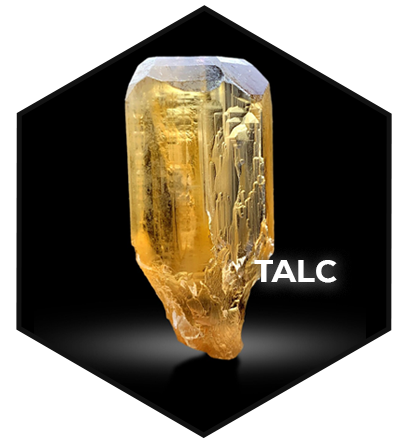
TALC
Talc, a soft mineral with a white, powdery appearance, has a wide range of industrial and consumer applications. Composed mainly of magnesium, silicon, and oxygen, talc is renowned for its ability to absorb moisture and provide a silky, smooth texture, making it a common ingredient in cosmetics, body powders, and personal care products. It is also used as a lubricant in various applications, such as in the pharmaceutical and food industries, where it prevents products from sticking to machinery during production. Talc’s use in the manufacture of ceramics and paint is another notable application due to its ability to enhance properties like brightness and opacity. However, concerns have been raised regarding the potential health risks associated with asbestos contamination
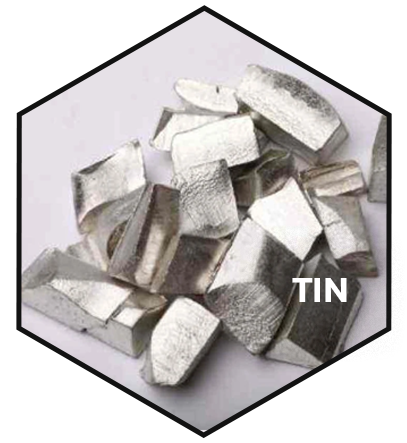
TIN
Tin, a silvery-white metal, has a rich history that spans centuries and has influenced human society in various ways. It is notable for its malleability, corrosion resistance, and relatively low melting point. Tin was one of the first metals to be used by humans, dating back to the Bronze Age, when it was alloyed with copper to create bronze, a durable material for tools, weapons, and art. The traditional association of tin with food preservation comes from its use as a coating for steel cans, hence the term “tin can.” Tin also plays a critical role in the production of solder, which is vital in electronics and plumbing. However, tin mining has environmental and social consequences in some regions, with efforts underway to promote sustainable mining practices. The versatile applications of tin and its historical significance in metallurgy and packaging underscore its continuing importance in modern industry and everyday life.
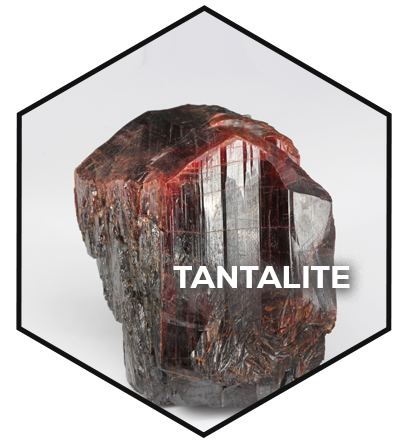
TANTALITE
Tantalite, a mineral group primarily composed of tantalum and niobium oxides, has considerable industrial significance. Its name is derived from the element tantalum, which is known for its high melting point and corrosion resistance, making it an essential component in capacitors used in electronics. The niobium content of tantalite is equally crucial, as niobium is used in superalloys for aerospace applications and in the manufacturing of high-temperature equipment. Tantalite deposits are found in various parts of the world, with some of the largest reserves in countries like the Democratic Republic of Congo. However, the mining of tantalite has been associated with ethical concerns, particularly in conflict regions where it has been linked to financing armed conflicts. As a result, there have been increasing efforts to establish responsible sourcing and ethical mining practices to ensure that tantalite and similar minerals are extracted and traded without human rights abuses or environmental degradation. Tantalite’s value lies in its pivotal role in advancing technology and its potential to contribute to ethical and sustainable mining practices in the future.
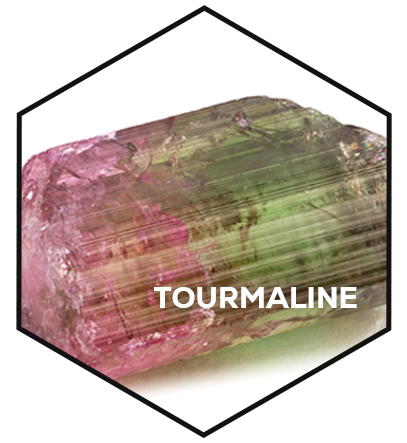
TOURMALINE
Tourmaline is a fascinating and diverse group of gemstones known for their captivating colours and unique optical properties. This complex mineral family encompasses a wide spectrum of hues, with some tourmalines displaying multiple colours in a single crystal, a phenomenon known as “bicolour” or “watermelon” tourmaline. Tourmaline’s electric charge properties, known as pyroelectricity and piezoelectricity, make it a valuable tool in scientific instruments and equipment. The most prized varieties of tourmaline include the vivid green “chrome tourmaline,” the intense pink “rubellite,” and the striking blue “indicolite.” Its versatility and mesmerizing range of colours have cemented tourmaline’s status as a cherished gemstone in the jewelry industry, adorning exquisite pieces and captivating gem enthusiasts worldwide.

